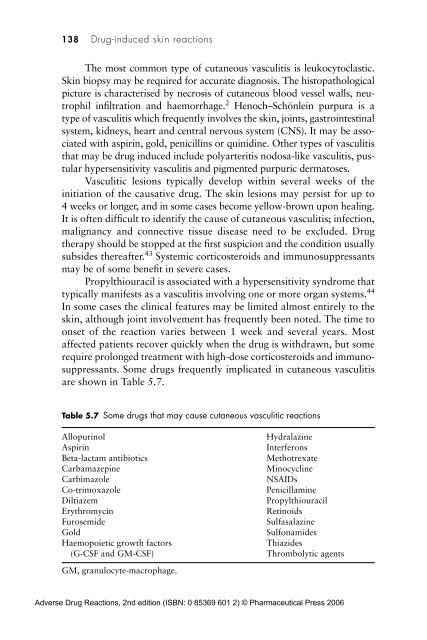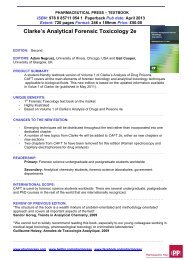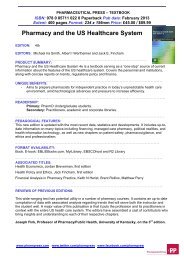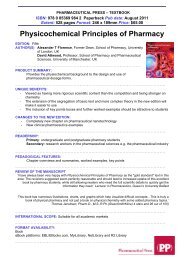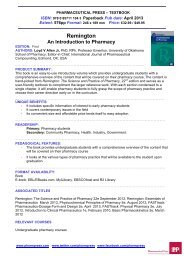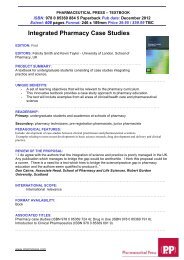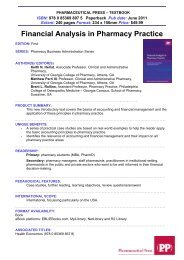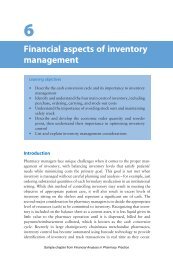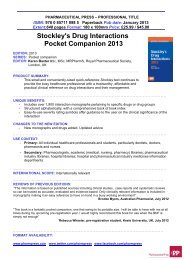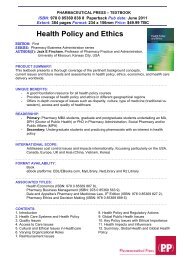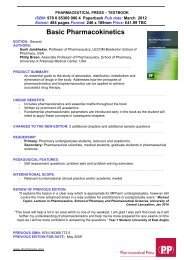Drug-induced skin reactions - Pharmaceutical Press
Drug-induced skin reactions - Pharmaceutical Press
Drug-induced skin reactions - Pharmaceutical Press
You also want an ePaper? Increase the reach of your titles
YUMPU automatically turns print PDFs into web optimized ePapers that Google loves.
138 <strong>Drug</strong>-<strong>induced</strong> <strong>skin</strong> <strong>reactions</strong><br />
The most common type of cutaneous vasculitis is leukocytoclastic.<br />
Skin biopsy may be required for accurate diagnosis. The histopathological<br />
picture is characterised by necrosis of cutaneous blood vessel walls, neutrophil<br />
infiltration and haemorrhage. 2 Henoch–Schönlein purpura is a<br />
type of vasculitis which frequently involves the <strong>skin</strong>, joints, gastrointestinal<br />
system, kidneys, heart and central nervous system (CNS). It may be associated<br />
with aspirin, gold, penicillins or quinidine. Other types of vasculitis<br />
that may be drug <strong>induced</strong> include polyarteritis nodosa-like vasculitis, pustular<br />
hypersensitivity vasculitis and pigmented purpuric dermatoses.<br />
Vasculitic lesions typically develop within several weeks of the<br />
initiation of the causative drug. The <strong>skin</strong> lesions may persist for up to<br />
4 weeks or longer, and in some cases become yellow-brown upon healing.<br />
It is often difficult to identify the cause of cutaneous vasculitis; infection,<br />
malignancy and connective tissue disease need to be excluded. <strong>Drug</strong><br />
therapy should be stopped at the first suspicion and the condition usually<br />
subsides thereafter. 43 Systemic corticosteroids and immunosuppressants<br />
may be of some benefit in severe cases.<br />
Propylthiouracil is associated with a hypersensitivity syndrome that<br />
typically manifests as a vasculitis involving one or more organ systems. 44<br />
In some cases the clinical features may be limited almost entirely to the<br />
<strong>skin</strong>, although joint involvement has frequently been noted. The time to<br />
onset of the reaction varies between 1 week and several years. Most<br />
affected patients recover quickly when the drug is withdrawn, but some<br />
require prolonged treatment with high-dose corticosteroids and immunosuppressants.<br />
Some drugs frequently implicated in cutaneous vasculitis<br />
are shown in Table 5.7.<br />
Table 5.7 Some drugs that may cause cutaneous vasculitic <strong>reactions</strong><br />
Allopurinol<br />
Aspirin<br />
Beta-lactam antibiotics<br />
Carbamazepine<br />
Carbimazole<br />
Co-trimoxazole<br />
Diltiazem<br />
Erythromycin<br />
Furosemide<br />
Gold<br />
Haemopoietic growth factors<br />
(G-CSF and GM-CSF)<br />
GM, granulocyte-macrophage.<br />
Hydralazine<br />
Interferons<br />
Methotrexate<br />
Minocycline<br />
NSAIDs<br />
Penicillamine<br />
Propylthiouracil<br />
Retinoids<br />
Sulfasalazine<br />
Sulfonamides<br />
Thiazides<br />
Thrombolytic agents<br />
Adverse <strong>Drug</strong> Reactions, 2nd edition (ISBN: 0 85369 601 2) © <strong>Pharmaceutical</strong> <strong>Press</strong> 2006


